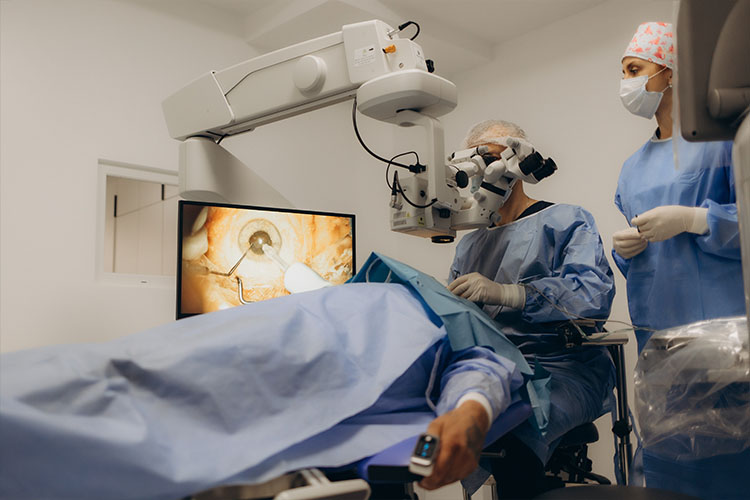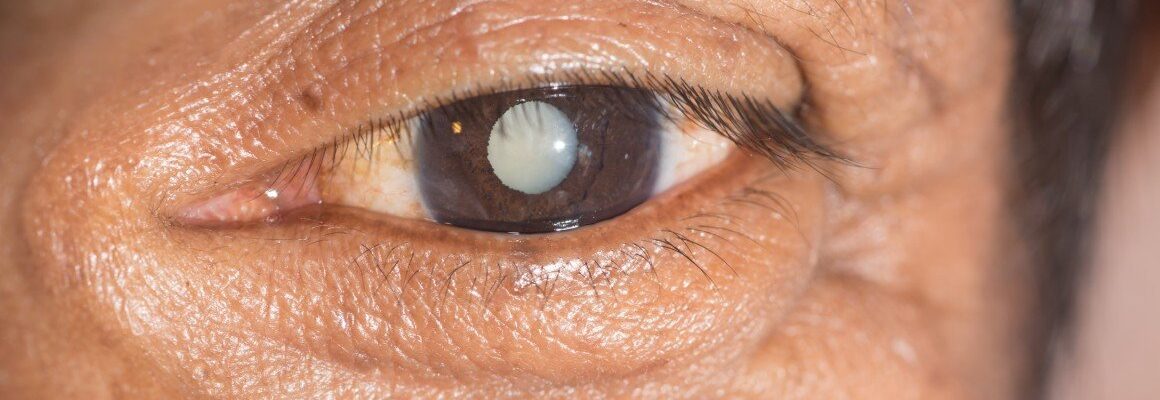Overview
Cataracts are a common eye condition where the natural lens of the eye becomes cloudy, leading to blurred vision, sensitivity to light, and, eventually, significant vision impairment if left untreated. This condition typically develops gradually as part of the aging process, but can also result from injury, certain medical conditions, or genetic factors. Cataracts are a leading cause of vision loss worldwide, but they are treatable with a high success rate.
Treatment for cataracts depends on the severity of the condition and how much it affects daily life. In the early stages, symptoms can sometimes be managed with stronger prescription eyeglasses, anti-glare sunglasses, and brighter lighting. However, as the cataract progresses, these measures may become less effective, and surgery becomes the most viable option. Cataract surgery involves removing the cloudy lens and replacing it with a clear artificial lens, restoring clear vision. This outpatient procedure is safe and highly effective, with most patients experiencing significant improvements in vision.
With timely intervention, cataracts can be treated successfully, allowing individuals to regain clear vision and maintain their quality of life. Regular eye exams are essential for early detection, as they can help monitor the cataract’s progression and determine the right time for treatment.
Table of Contents
When to See a Doctor
If you notice changes in your vision that interfere with daily activities, it’s essential to consult an eye doctor to assess for cataracts or other eye conditions. Early diagnosis allows for better management of symptoms and timely treatment to prevent further vision impairment.

You should consider seeing a doctor if:
- You experience blurred, clouded, or dimmed vision that makes it difficult to read, drive, or recognize faces.
- You become unusually sensitive to light and glare, especially from headlights, lamps, or sunlight.
- You see halos around lights or have difficulty seeing at night.
- Your vision appears faded or has a yellowish tint, making colors appear less vibrant.
- You find that your eyeglass or contact lens prescription needs frequent updating but still doesn’t improve clarity.
Seeking medical attention early can help prevent cataracts from impacting your quality of life and can guide you toward the most appropriate treatment options.
What Type of Doctor to Seek
For cataracts, consult an ophthalmologist or an optometrist. An optometrist can perform an eye exam to diagnose cataracts and may provide initial guidance on managing symptoms in the early stages. However, for advanced cataracts that require surgery, an ophthalmologist, who specializes in medical and surgical eye care, is the appropriate specialist. They can assess the need for surgery and perform the procedure if necessary.
If you are experiencing significant visual changes, seeing an ophthalmologist early can streamline the treatment process, as they can monitor the cataract’s progression and recommend surgery at the optimal time.
What to Expect From Your First Doctor Visit
During your first visit, the doctor will perform a comprehensive eye examination to assess the cataract’s size, location, and impact on your vision. Here’s what to expect:
- Medical and Vision History Review. The doctor will ask about any symptoms, such as blurred vision, light sensitivity, or changes in color perception, and review any family history of cataracts or other eye conditions.
- Visual Acuity Test. This test measures your ability to see at various distances, helping the doctor determine how the cataract affects your vision and how it may impact daily activities like reading or driving.
- Slit-Lamp Examination. The doctor will use a slit-lamp microscope to examine the structures of your eye in detail, including the lens, cornea, iris, and retina. This helps assess the extent and location of the cataract.
- Retinal Exam. The doctor may dilate your pupils with eye drops to get a better view of the retina and optic nerve, allowing them to evaluate any underlying eye health issues.
Following the examination, the doctor will discuss possible treatment options. For mild cataracts, they may suggest measures like updated prescription glasses or lifestyle adjustments to manage symptoms. If the cataract is advanced, they may recommend cataract surgery and provide guidance on the procedure, recovery, and expected outcomes. Early consultation ensures that any necessary treatment can be provided promptly, helping maintain clear vision and quality of life.
Cataract Treatment Options
In the early stages of cataracts, it is possible to manage symptoms without surgery. This can be done by wearing prescription eyeglasses, increasing lighting in dim rooms, using anti-glare sunglasses outdoors, and employing a magnifying lens for reading. These adjustments can help improve vision temporarily by reducing glare and enhancing clarity.
 However, if these measures are no longer effective, surgery may be necessary to remove the cataract and restore vision. Here are the main types of cataract surgery:
However, if these measures are no longer effective, surgery may be necessary to remove the cataract and restore vision. Here are the main types of cataract surgery:
- Small-Incision Surgery (Phacoemulsification). In this procedure, the surgeon makes a small incision in the cornea. A tiny instrument is then inserted, emitting ultrasound waves that break down the cataract in the lens, which is then removed. An artificial lens, called an intraocular lens (IOL), is implanted in its place to restore vision. This technique allows for a quick recovery and is the most commonly used cataract surgery method.
- Large-Incision Surgery (Extracapsular Cataract Extraction). This less common procedure is typically used for larger, denser cataracts that severely affect vision. The surgeon makes a larger incision in the eye to remove the affected lens in one piece before replacing it with an artificial lens. Due to the size of the incision, this procedure often requires a longer healing period compared to small-incision surgery.
- Femtosecond Laser Surgery. This advanced technique uses a femtosecond laser to break up the cataract instead of ultrasound. It is often preferred for patients with additional conditions, like astigmatism, as it allows for precise corrections. Once the lens is fragmented, it is removed and replaced with an artificial lens. Laser-assisted cataract surgery is highly precise and may offer faster recovery in some cases.
Each surgical method is chosen based on the severity of the cataract and any additional eye conditions the patient may have. Consulting an eye specialist will help determine the most suitable approach. With modern cataract surgeries, most patients achieve significant improvements in vision and experience a smooth recovery with proper post-operative care.
Cataract Prognosis
The prognosis for cataracts is highly favorable, especially with timely treatment. In the early stages, cataracts can often be managed with adjustments to prescription eyewear and lifestyle changes, which can help maintain vision quality for a period of time. However, as cataracts progress, they typically require surgical removal to restore clear vision. Cataract surgery is one of the most commonly performed and successful surgeries worldwide, with a high rate of positive outcomes.
Following cataract surgery, most patients experience a significant improvement in vision, often within just a few days. Many regain excellent clarity and contrast in their vision, allowing them to resume daily activities without difficulty. Complications from cataract surgery are rare, but regular follow-up appointments are essential to monitor healing and address any issues that may arise, such as inflammation or infection. In some cases, a secondary cataract (posterior capsule opacification) may develop, but this can be easily treated with a quick, painless laser procedure.
Overall, with early detection and appropriate management, cataracts have an excellent prognosis. For those who undergo cataract surgery, the likelihood of full vision restoration is very high, enabling individuals to enjoy a clear and active lifestyle long after treatment.


